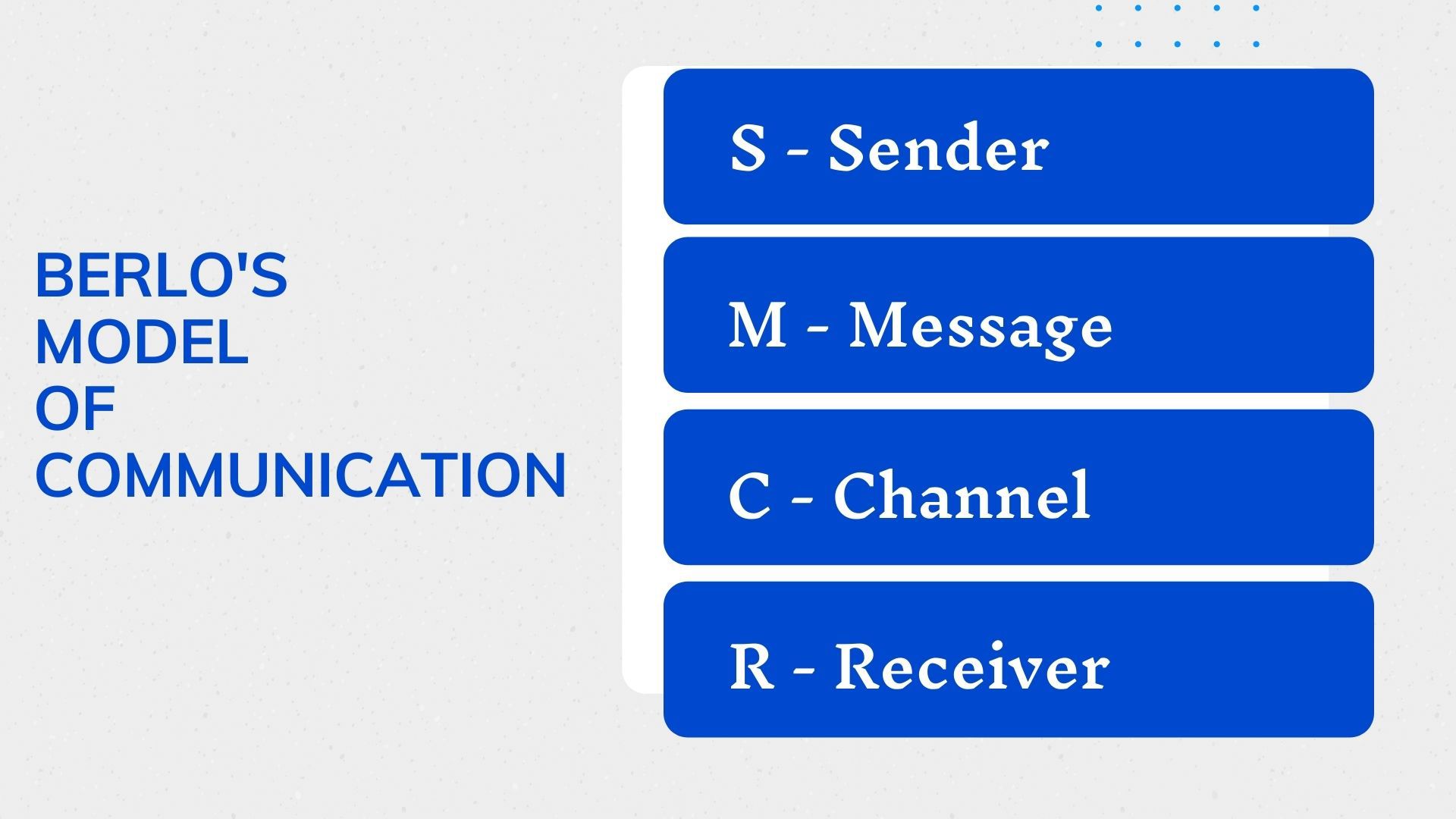
Understanding the Berlos Model of Communication - Types, Differences, and Steps

Berlo's Model of Communication, also known as the SMCR model, was developed by David Berlo in the 1960s It consists of four components: Sender, Message, Channel, and Receiver This model helps to identify and understand the communication process Advantages include clear communication and better understanding, while limitations include oversimplification and lack of feedback
David Berlo introduced the SMCR model of communication in the 1960s, which emphasizes the significance of the emotional aspect of the message in effective communication. Unlike the Aristotle model, which places speakers at the center, this model focuses on four essential components: Source, Message, Channel, and Receiver, abbreviated as SMCR.
SCMR Model of Communication
1. S – Sender
In any communication model, the sender is the initiator of the message and is responsible for composing and transmitting it to the receiver. The receiver then decodes the message to understand its meaning. While the sender plays a crucial role in communication, they are not always the sole source of information, as messages may also be relayed through other channels.
Factors related to or affecting the sender:
1.1 Communication
The effectiveness of communication lies in the sender's or receiver's proficiency in communication. The message's accuracy is contingent on the sender's ability to communicate effectively.
If the message is not articulated correctly, the intended meaning may not be conveyed. Furthermore, if the receiver lacks communication skills, they may not be able to comprehend the message since communication necessitates both speaking and active listening.
Also, other skills like listening, writing, reading, etc. depends on communication skills, and if they are not good enough, then the process of communication will not be effective.
1.2 Attitude
The meaning of a message is shaped by the attitudes of both the sender and receiver. A sender's attitude towards the message, the receiver, and themselves, combined with the receiver's attitude, determine the overall tone and impact of the communication. A positive attitude from the sender will convey a different meaning than a negative attitude.
Having sufficient knowledge and familiarity with the subject matter can greatly impact the effectiveness of a message between a sender and receiver. Conversely, lacking knowledge or understanding of the topic can lead to ineffective communication and potential errors in message interpretation.
1.4 Social systems
There are many social systems between the sender and the receiver, which affects the message. There may be values, laws, etc. which may affect the sender.
plays a significant role in effective communication, especially in cross-cultural communication. When people from different cultural backgrounds interact, they bring with them their own set of values, beliefs, and customs, which can impact how they interpret and respond to messages. In order to overcome these barriers, it is important to have a basic understanding of the other culture and to adapt communication strategies accordingly. This can include using simple language, avoiding idioms and slang, and being mindful of nonverbal cues. By doing so, effective cross-cultural communication can be achieved, and messages can be conveyed successfully.
Different cultures may interpret messages differently, even if it's the same message. What's considered acceptable in one culture may not be in another. Understanding these nuances is crucial for effective communication in a multi-cultural setting.
2. M – Message
delivery and reception can include the sender's tone, body language, and the environment in which the communication takes place. The receiver's level of attention, understanding, and interpretation of the message can also play a role in the effectiveness of communication. Overall, effective communication requires not only clear and concise message delivery but also active listening and comprehension on the part of the receiver.
Poorly structured messages can lead to confusion and misunderstandings between the sender and receiver. Therefore, it is important for the sender to organize the message in a clear and concise manner, ensuring that the main points are easily understood. By doing so, the receiver will be able to interpret the message accurately and respond appropriately. Ultimately, a well-structured message can lead to better communication and more successful outcomes.
Content refers to the subject matter of a message, whether it's conveyed through audio, video, text, or a combination of these formats. It is an essential component of every message, and its quality plays a crucial role in engaging the receiver's attention and appreciation.
The way in which the message is conveyed to the recipient is referred to as treatment. The treatment given to the message can impact the recipient's feedback. It is crucial to understand the significance of the communication message and be capable of handling it effectively.
A message is comprised of non-verbal elements such as tone, facial expressions, signs, and gestures. These elements can include a variety of physical movements, such as hand gestures and facial expressions.
The code of a message refers to the method in which it is transmitted. Examples of codes include audio, text, video, and sound. Think of the code as a password - if the wrong one is entered, the account won't open. Likewise, using the wrong code will cause the message to be disrupted.
3. C – Channel
In the world of communication, the channel used to transmit a message is referred to as the medium. Communication channels vary depending on the type of message being conveyed and may include options such as the internet, radio, television, print, and more.
The hearing channel involves the use of sound to convey a message. The effectiveness of this channel depends on factors such as the clarity and volume of the sound, as well as the listener's ability to hear. It is important for the message sender to ensure that the sound quality is optimal for the intended audience to fully comprehend the message.
The message that we receive through hearing.
3.2 Seeing
The messages which are received by seeing, be it verbal or non-verbal
3.3 Touching
While verbal communication occurs with a proper medium like text or picture, non-verbal communication primarily takes by a handshake, or a frown or happy look.
3.4 Smelling
A lot of information such as fragrance, the freshness of the product can be known by smelling.
3.5 Tasting
Useful information such as the quality or taste of the product can be sent as a message via taste.
4. R – Receiver
The receiver plays a crucial role in the communication process as they are responsible for decoding and comprehending the message sent by the sender. Berlo's model of communication emphasizes the importance of synchronization between the sender's factors and thinking pattern to enhance the effectiveness of communication. However, it is essential that the sender and receiver share similarities, as a message may not have the same impact on someone from a different cultural background, such as an Indian man listening to an Arabic advertisement on the radio.
For effective communication, the sender and receiver must share similar cultural and social backgrounds. Without this similarity, the message may not inspire the desired action, thus rendering communication ineffective. To understand this concept better, you can watch a video on the Berlos Model of Communication.
Advantages
The simplicity of this model distinguishes it from contemporary communication models. It encompasses all the fundamental elements of communication while acknowledging the variables that impact them. As a result, this model is still utilized in certain scenarios where communication is in its most authentic form, such as face-to-face interactions.
This model forms a basis for higher communication models.
Limitations
Noise is the main culprit behind message failure, and this model fails to account for it or any other communication limitations. In today's world, most messages are lost due to noise. As a result, marketers and advertisers must take this into account when communicating with their customers.
:
In contrast to a two-way communication model, the lack of feedback in this approach is a significant drawback. Feedback plays a vital role in effective communication, particularly in today's competitive and dynamic markets.
:
The Berlos model holds significant importance in comprehending the different components of the communication model as well as the variables that impact them. It serves as a valuable tool for developing and comprehending fundamental communication processes.
Shannon and Weaver Model of Communication
PREV
Schramm model of communication
START
Communication Models









